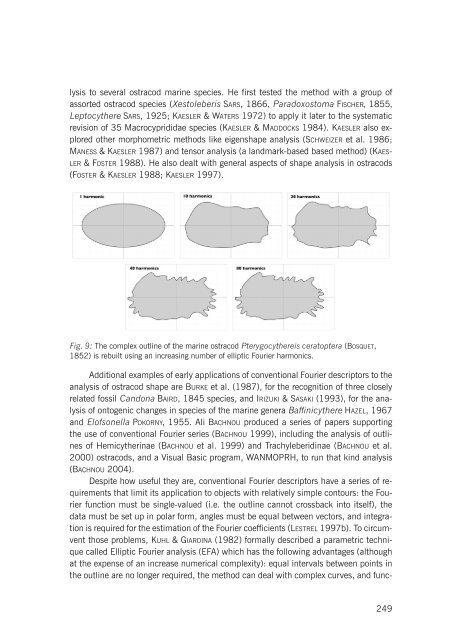Geo11_89_Baltanas_Danielopol_Geometric_Morphometrics
Geo11_89_Baltanas_Danielopol_Geometric_Morphometrics
Geo11_89_Baltanas_Danielopol_Geometric_Morphometrics
You also want an ePaper? Increase the reach of your titles
YUMPU automatically turns print PDFs into web optimized ePapers that Google loves.
lysis to several ostracod marine species. He first tested the method with a group of<br />
assorted ostracod species (Xestoleberis SARS, 1866, Paradoxostoma FISCHER, 1855,<br />
Leptocythere SARS, 1925; KAESLER & WATERS 1972) to apply it later to the systematic<br />
revision of 35 Macrocyprididae species (KAESLER & MADDOCKS 1984). KAESLER also explored<br />
other morphometric methods like eigenshape analysis (SCHWEIZER et al. 1986;<br />
MANESS & KAESLER 1987) and tensor analysis (a landmark-based based method) (KAES-<br />
LER & FOSTER 1988). He also dealt with general aspects of shape analysis in ostracods<br />
(FOSTER & KAESLER 1988; KAESLER 1997).<br />
Fig. 9: The complex outline of the marine ostracod Pterygocythereis ceratoptera (BOSQUET,<br />
1852) is rebuilt using an increasing number of elliptic Fourier harmonics.<br />
Additional examples of early applications of conventional Fourier descriptors to the<br />
analysis of ostracod shape are BURKE et al. (1987), for the recognition of three closely<br />
related fossil Candona BAIRD, 1845 species, and IRIZUKI & SASAKI (1993), for the analysis<br />
of ontogenic changes in species of the marine genera Baffinicythere HAZEL, 1967<br />
and Elofsonella POKORNY, 1955. Ali BACHNOU produced a series of papers supporting<br />
the use of conventional Fourier series (BACHNOU 1999), including the analysis of outlines<br />
of Hemicytherinae (BACHNOU et al. 1999) and Trachyleberidinae (BACHNOU et al.<br />
2000) ostracods, and a Visual Basic program, WANMOPRH, to run that kind analysis<br />
(BACHNOU 2004).<br />
Despite how useful they are, conventional Fourier descriptors have a series of requirements<br />
that limit its application to objects with relatively simple contours: the Fourier<br />
function must be single-valued (i.e. the outline cannot crossback into itself), the<br />
data must be set up in polar form, angles must be equal between vectors, and integration<br />
is required for the estimation of the Fourier coefficients (LESTREL 1997b). To circumvent<br />
those problems, KUHL & GIARDINA (1982) formally described a parametric technique<br />
called Elliptic Fourier analysis (EFA) which has the following advantages (although<br />
at the expense of an increase numerical complexity): equal intervals between points in<br />
the outline are no longer required, the method can deal with complex curves, and func-<br />
249


